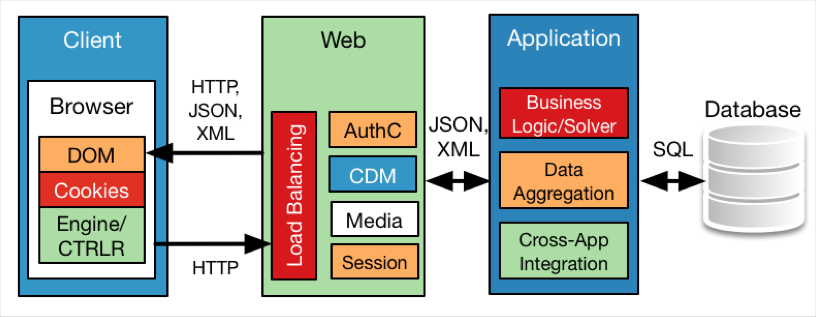The Model-View-Controller (MVC) design is a functional model that guides the separation of information and exposure, and to some degree, also addresses the privileges of the stakeholder users through role separation. This allows the application to keep users and their inputs from intermingling with the back-end business processes, logic, and transactions that can expose earlier architectures to data leakage. The MVC design approach was actually created by thick-application software developers and is not a logical separation of services and components but rather a role-based separation. Now that web applications commonly have to scale while tracking and enforcing roles, web application developers have adapted it to their use. MVC designs also facilitate code reuse and parallel module development.
An MVC design can be seen in following figure:
The Model-View-Controller design focuses on roles, not functions, and is often combined with a functional architecture.
In the MVC design, the four components are as follows:
- Model: The model maintains and updates data objects as the source of truth for the application, possessing the rules, logic, and patterns that make the application valuable. It has no knowledge of the user, but rather receives calls from the controller to process commands against its own data objects and returns its results to both the controller and the view. Another way to look at it is that the Model determines the behavior of the application.
- View: The view is responsible for presenting the information to the user, and so, it is responsible for the content delivery and responses: taking feedback from the controller and results from the model. It frames the interface that the user views and interacts with. The view is where the user sees the application work.
- Controller: The controller acts as the central link between the view and model; in receiving input from the view's user interface, the Controller translates these input calls to requests that the model acts on. These requests can update the Model and act on the user's intent or update the View presented to the user. The controller is what makes the application interactive, allowing the outside world to stimulate the model and alter the view.
- User: As in the other earlier models, the user is an inferred component of the design; and indeed, the entire design will revolve around how to allow the application to deliver value to the customer.
Notice that in the MVC model, there is very little detail given about software modules, and this is intentional. By focusing on the roles and separation of duties, software (and now, web) developers were free to create their own platform and architecture while using MVC as a guide for role-based segmentation. Contrast this with the standalone or 3-tier models break down the operation of an application, and we'll see that they are thinking about the same thing in very different ways.
One thing MVC does instill is a sense of statefulness, meaning that the application needs to track session information for continuity. This continuity drove the need for HTTP cookies and tokens to track sessions, which are in themselves something our app developers should now find ways to secure. Heavy use of application programming interfaces (APIs) also mean that there is now a larger attack surface. If the application is only presenting a small portion of data stored within the database tier, or that information should be more selectively populated to avoid leaks by maintaining too much information within the model that can be accessed when misconfigured or breached. In these cases, MVC is often shunned as a methodology because it can be difficult to manage data exposure within it.
It should be noted that the MVC design approach can be combined with physical or logical models of functions; in fact, platforms that use some MVC design principles power the majority of today's web applications.






